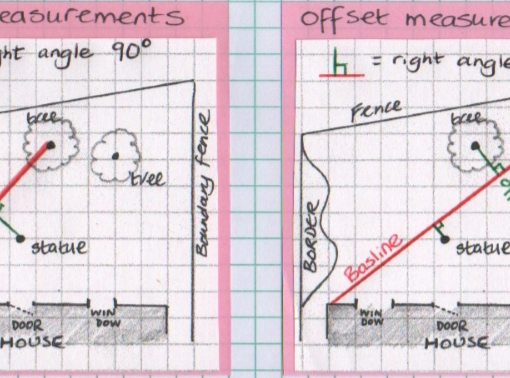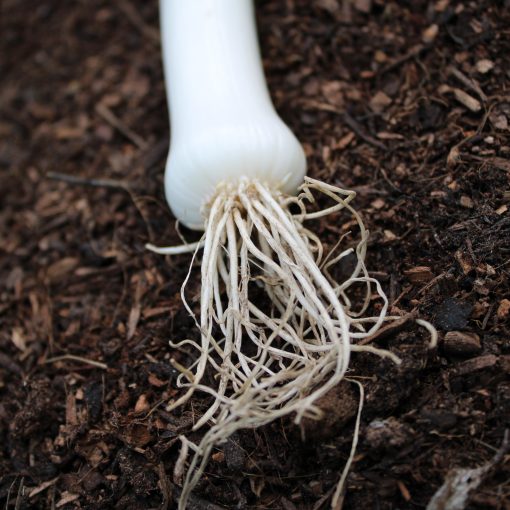This is a named pest to be studied as part of the old RHS syllabus R2103. It is also relevant to the new syllabus Unit 1 Topic 2 Plant Health as a named example of a pest.
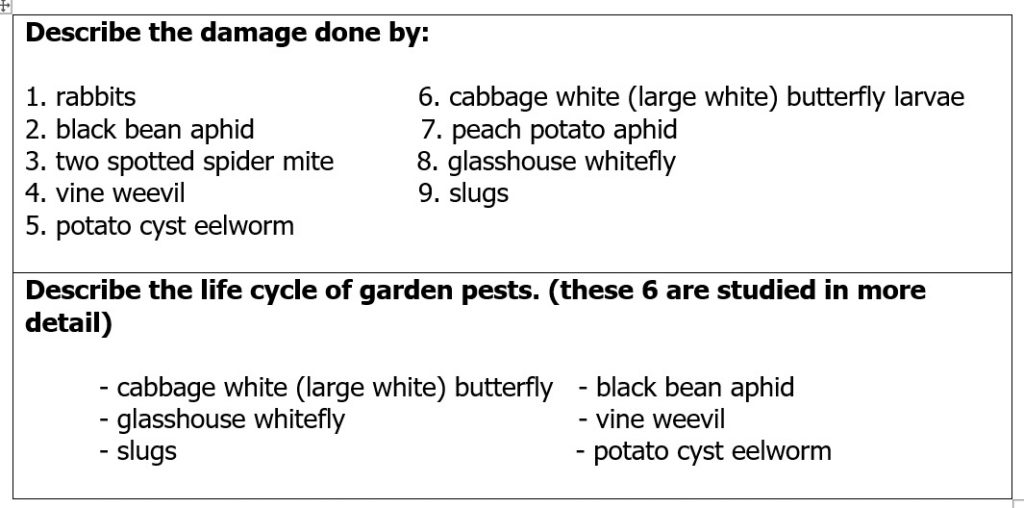
Introduction
Plant pest =
Any insect or animal that causes unacceptable levels of damage to cultivated plants, making them unsuitable for the purpose for which they were grown. Pests may affect the aesthetic value or crop yield.
Why pests need to be controlled.
If we think about this commercially there is a lot more at stake. Growers will lose money, crops may fail and businesses will close. For example, the Colorado beetle is not found in the UK yet- it is a major pest in Europe and the USA. Defra reported a siting of this beetle in 2015 which had come in on French potatoes. If Colorado beetle spread across the UK the potato business would be devastated and there would be a shortage of potatoes and those available would be more expensive. The business of pest control is a serious business.
Here is a link to information about the Colorado beetle: https://planthealthportal.defra.gov.uk/assets/factsheets/colorado-beetle-factsheet.pdf
In a garden situation good horticultural practice can limit pest damage because it is a smaller space to manage and there is more manual labour to do the work. We all aspire (I hope) to be organic gardeners but chemicals still need to be considered for commercial production methods.
Reasons to control pests:
- Reduced yield (Vegetables and fruit)
- Spoilt ornamental value (Cut flower crops, poinsettias for Christmas, houseplants, garden plants) Most garden centre customers will only purchase perfect looking plants.
- Spoilt ornamental value and death of plants
Once purchased and planted in the garden or brought into the home, gardeners can perhaps tolerate a little pest or disease damage. However, some species have many predators and may be so badly damaged, they have to be replaced. For example, the Box plant (Buxus sempervirens)
https://www.rhs.org.uk/advice/profile?PID=851 This link describes 10 pests and diseases that can affect Buxus sempervirens. It even has its own specific red spider mite that attacks it. After reading this, it is clear why many designers are replacing box hedging with other look-alike species. Sometimes prevention is better than cure. - Health and safety implications
Oak processionary moth – Older caterpillars develop tiny hairs containing an irritating protein. Contact with the hairs can cause itching skin rashes, eye irritations, as well as sore throats and breathing difficulties in people and animals. The risk of exposure to these hairs is highest in May and June. This moth is only found in the South of England at present.
https://www.forestresearch.gov.uk/tools-and-resources/pest-and-disease-resources/oak-processionary-moth-thaumetopoea-procession - Loss of plants species which can have a detrimental impact on biodiversity.
Ash dieback disease – Death of large numbers of ash trees will have significant negative impact on other species that use ash trees as habitat such as fungi, birds, invertebrates, mammals, and lichens.
Organic growers are keen to promote biodiversity so that natural predators will feed on the pests. This is a more sustainable way of controlling pests. Some pests have to be tolerated so that birds and other predators can feed on them. Integrated pest management is the ideal approach to pest control. This method uses prevention, physical, cultural and biological control first with chemical control only being used as a last resort. It is important to note that chemicals used to kill pests will also kill beneficial insects which can control pests naturally.
Proforma for the study of pests
- Name of pest
- Appearance of pest – colour, size, type of mouthpart and how it feeds
- Symptoms of damage
- Main host plant(s)
- How it spreads
- 2 methods of control which are from different categories (biological, chemical, physical, cultural)
Two spotted spider mite / Red spider mite
There are many types of red spider mite which prefer different host plants and habitats. Here we are focussing on the GLASSHOUSE spider mite or Tetranychus urticae. Henceforth referred to as 2 spotted spider mite.
Appearance of two spotted spider mite
As the name suggests the minute mite has 2 large dark spots on either side of the body. The mites turn orange/red when they are inactive and hibernating over the Winter so are also called red spider mite. The term “spider” is a bit misleading, because it is a mite. However, it does have 8 legs, spins webs, and is related to the same zoological class as spiders, Arachnida.
This is a tiny (0.5mm) wingless mite that likes dry warm conditions so the heat of a greenhouse speeds up the life cycle.
Preferred conditions
This pest prefers hot dry conditions so its favourite habitat in the UK is greenhouses and on house plants in a warm centrally heated house. In very hot dry Summers it may also be found outside.
Preferred Host plants
It will feed on a wide range of plants including many greenhouse/house plants and some garden plants, eg Lemon trees, vines, peach, nectarines, cucumbers, tomatoes, aubergines, peppers, Fuchsia, Pelargonium, poinsettias.
Feeding – Spider mites lack chewing or piercing-sucking mouthparts. They use a pair of needle-like stylets to rupture leaf cells and then push their mouth into the torn tissue to drink the cell sap. Both immature and adult mites pierce plant tissues with their mouthparts and feed on cell contents.
Damage / Symptoms
- Fine pale mottling of upper surface of foliage and leaves turn yellow and fall. The ruptured leaf cells die and this is what causes the mottling pattern.
- Stunted growth
- Possible plant death.
- In heavy infestations you see fine silk webbing on the plants.
- The mites live on the underside of the leaves.
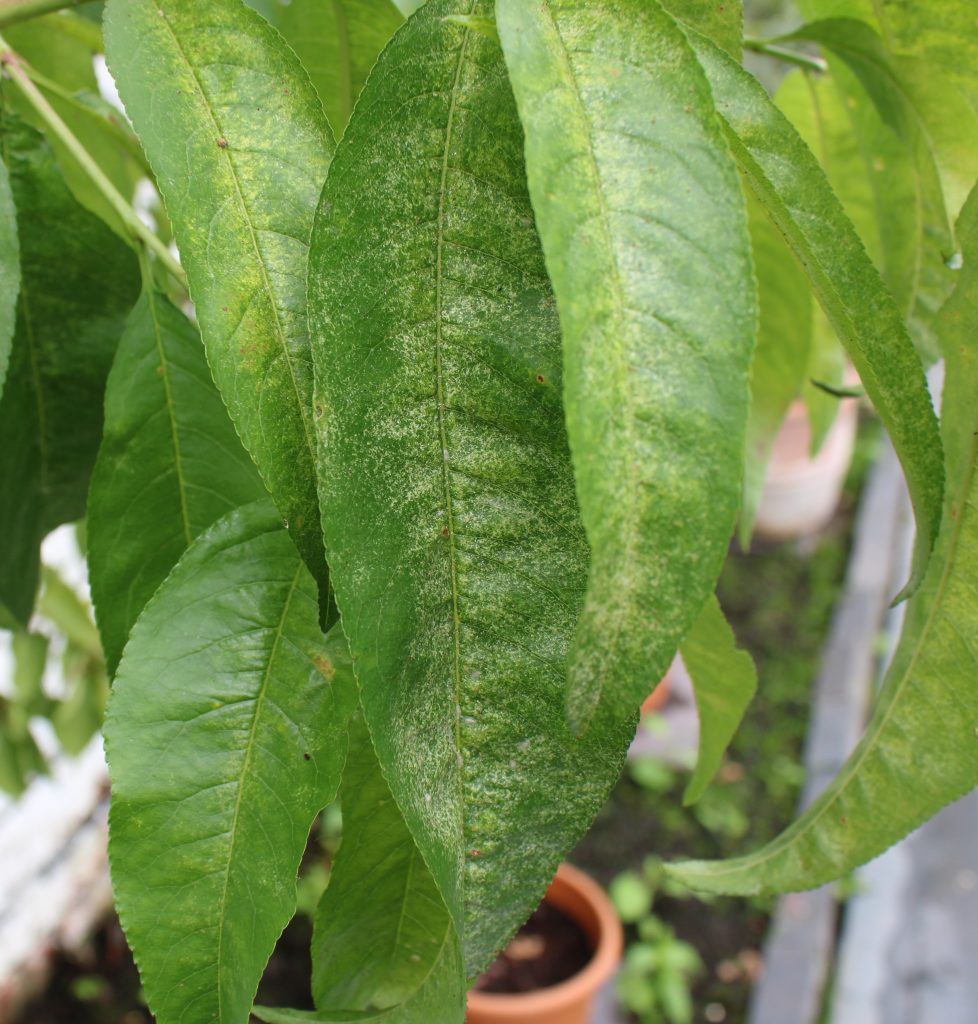

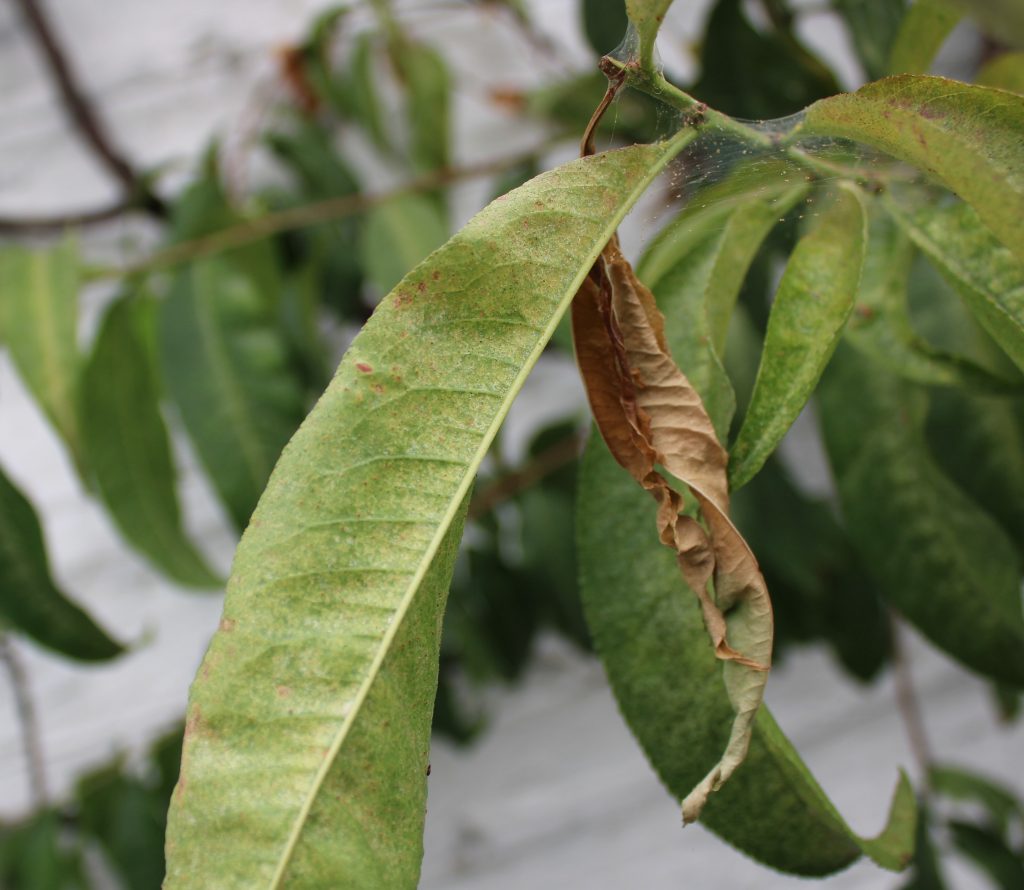
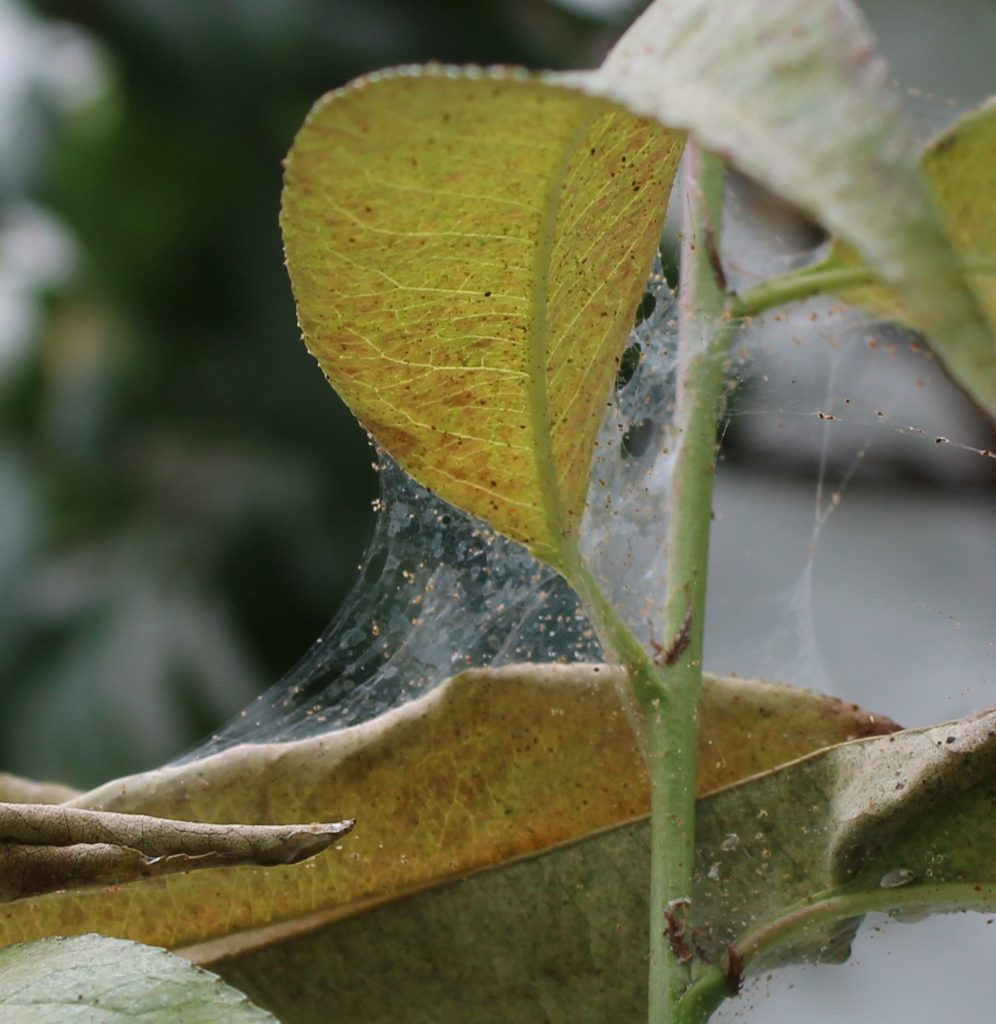
Spread
By movement of infected plants / clothing of staff. The life cycle speeds up as temperatures increases. The pest can hibernate in crevices over Winter. It is active in March to October but can be active all year round in a heated glasshouse or home (Houseplants). It thrives in warm, dry conditions.
Control
Cultural
- Remove severely infested plants from glasshouses in late summer before lower temperatures and shorter days induce the females to seek sheltered places where they will remain dormant for the winter period.
- Clear out possible shelters such as plant debris, old canes, etc before the spring.
- Once empty, clean glasshouse with disinfectant.
- During season keep weeds down as they can act as a host.
- Do not overcrowd plants and maintain humidity by damping down floors / spraying with water.
- Spray water onto the underside of leaves as the pest dislikes humidity and it reduces the breeding rate.
- Inspect new plants for presence of pest
Biological
- A predatory mite called Phytoseiulus persimilis feeds on the mite in the greenhouse environment.
Chemical
- A plant oil spray will block spiracles (Breathing pores)
- Fatty acids (soap sprays) dry out the cuticle and may block spiracles. Particularly effective as they have a soft body.
- Deltamethrin (Synthetic pyrethroid) affects nervous system
Summary of key facts for the exam
Name of pest: 2 spotted spider mite / red spider mite
Feeds on: greenhouse and house plants where the atmosphere is hot and dry. Lemon, tomato, cucumber.
Mouth parts: Needle like pincers tear away cell wall and they drink the sap.
Damage seen: Mottled leaves, webbing, yellow leaves, leaf fall, decreased plant vigour. Presence of tiny mites. Death eventually if infestation is severe.
When active: March-October. Rapid life cycle when temperatures are high. Hibernates over Winter in crevices.
Control: First try preventative measures and cultural control. Inspect new plants for pest. Keep greenhouse humid, spray plants, allow spacing of plants. Fumigate greenhouse in winter to kill over wintering mites.
When pest is active try biological control (a predatory mite) which eats the mite.
Chemical control (a last resort): Fatty acid spray, soap spray or deltamethrin. (This is NOT an endorsement of chemical use)
Details of the life cycle is not required for this pest for the old syllabus.
Further information can be found here:
- RHS overview: https://www.rhs.org.uk/advice/profile?pid=190
- Video close up of spider mite life: https://www.youtube.com/watch?v=jQGndjxuFpw


